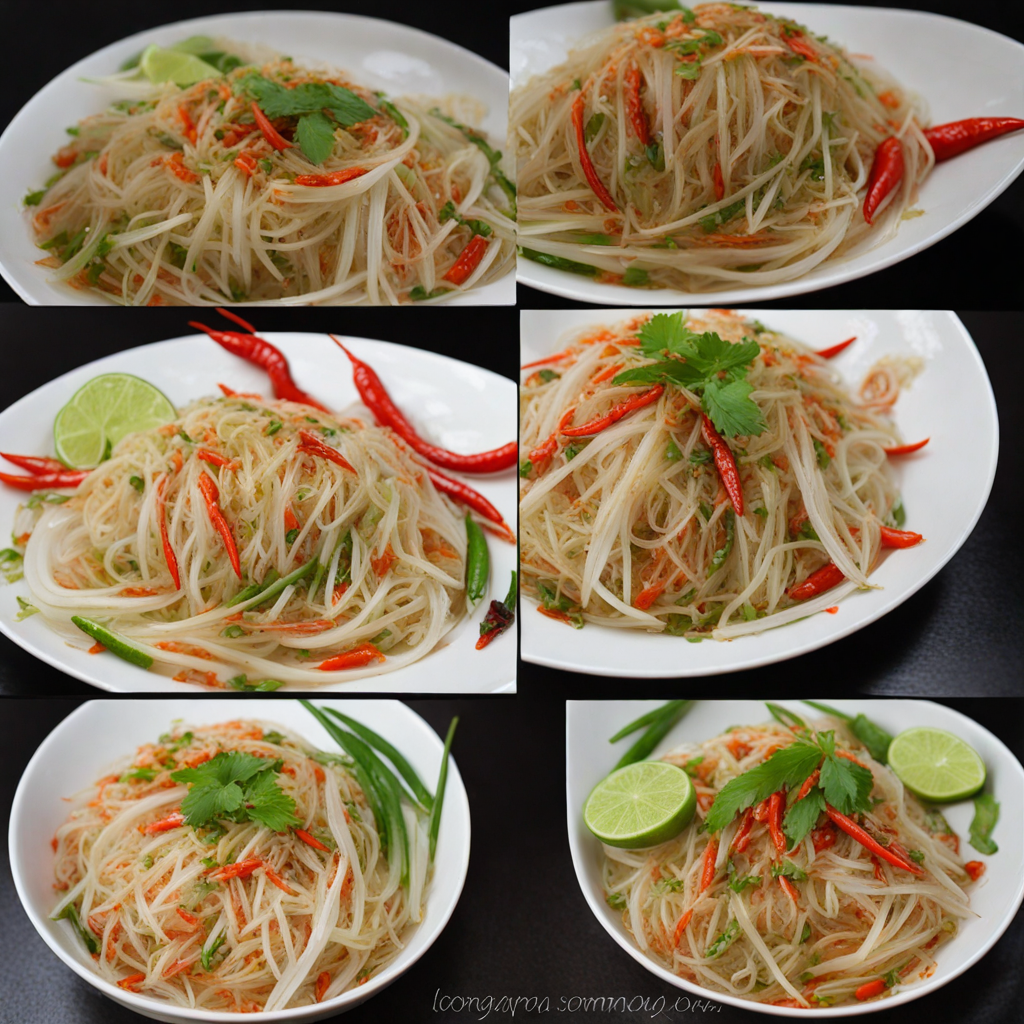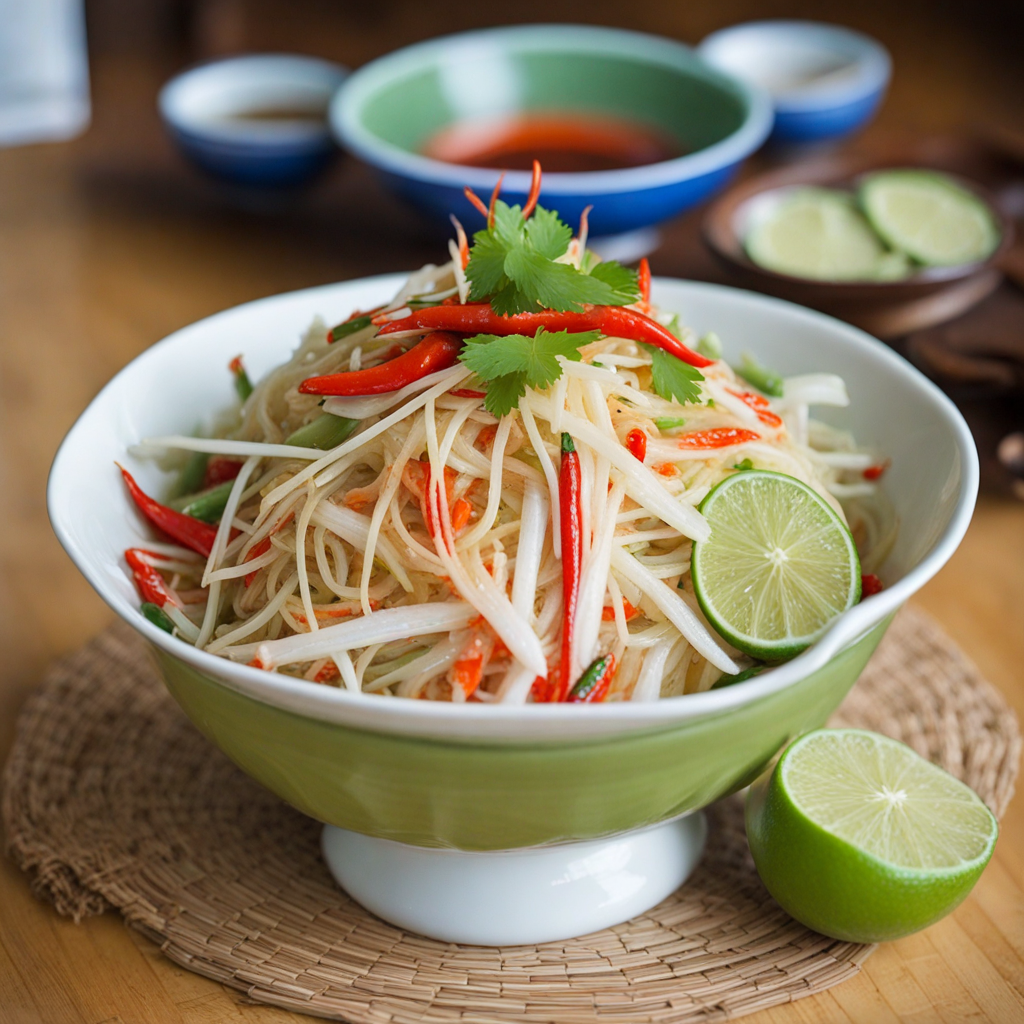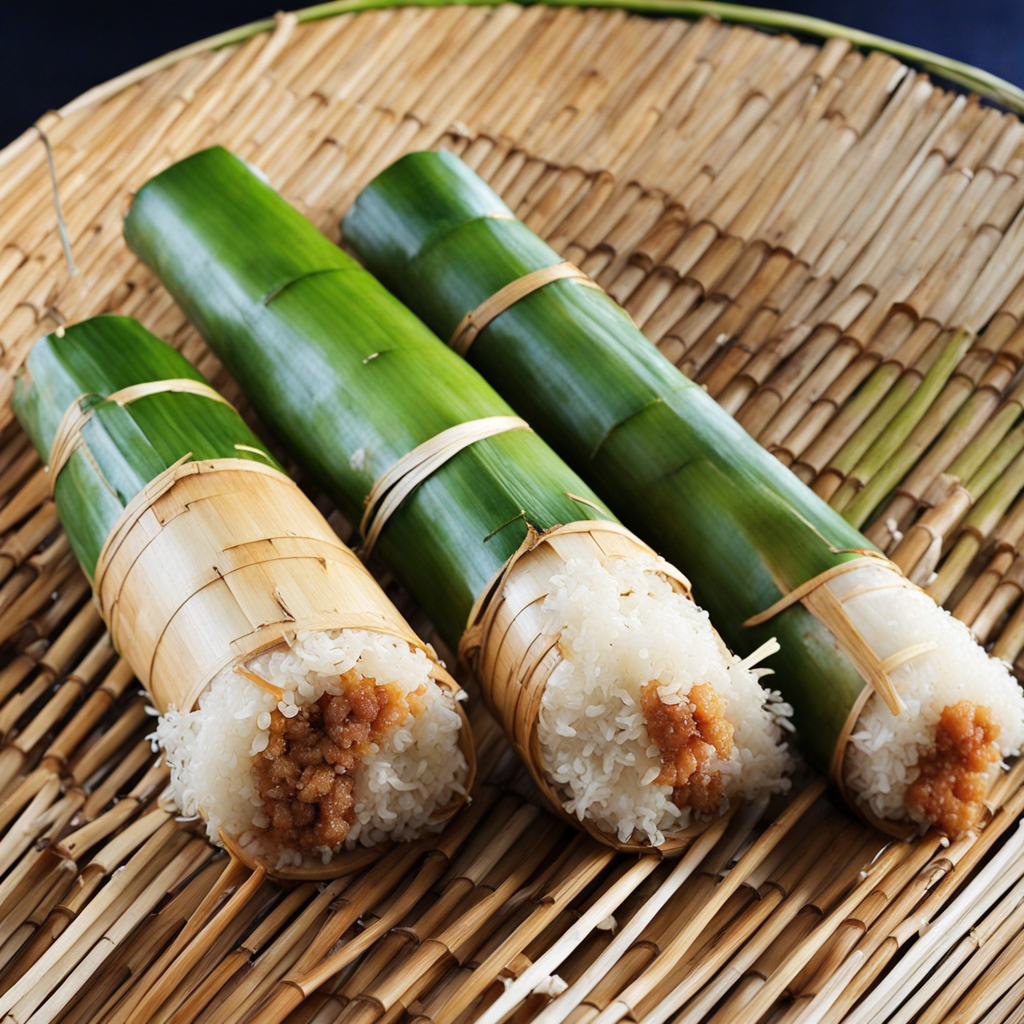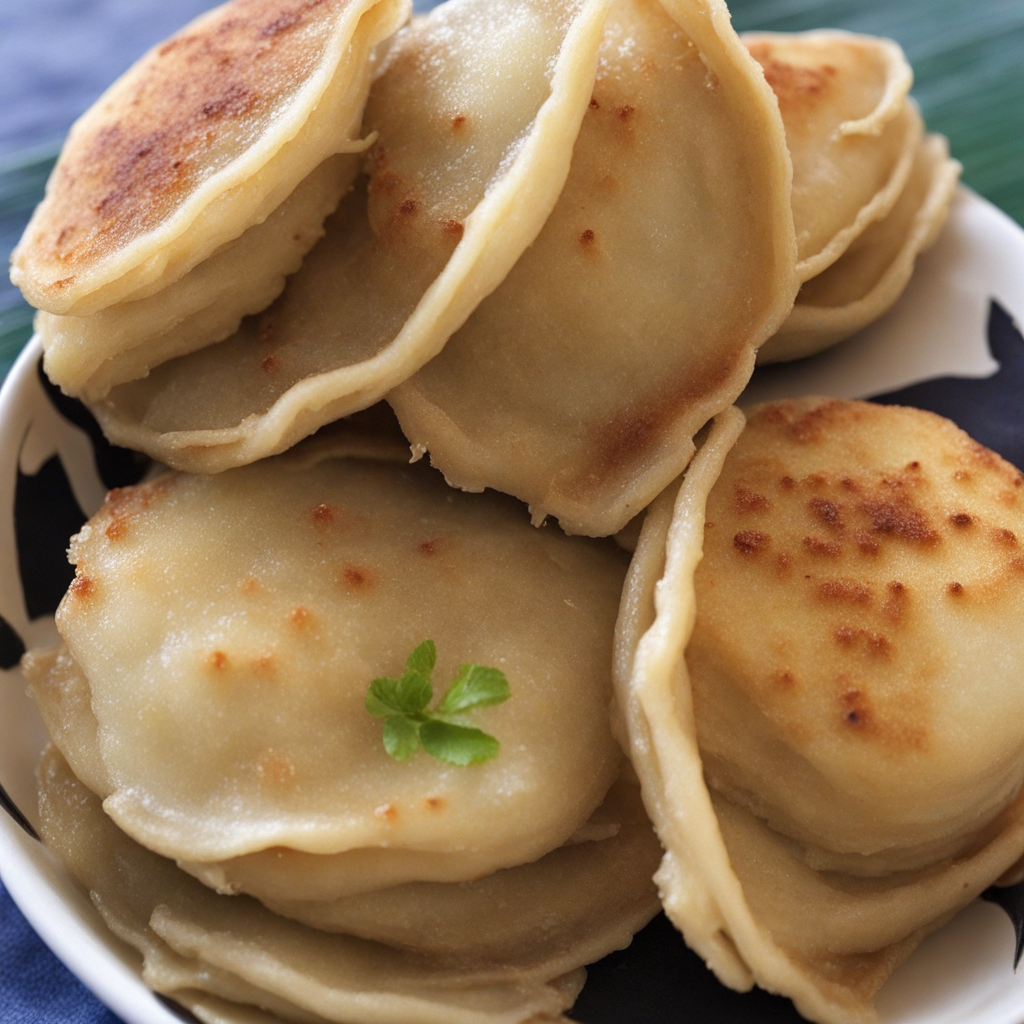Tam Mak Hoong
Tam Mak Hoong, a vibrant and refreshing dish from Laos, is essentially a green papaya salad that embodies the bold flavors characteristic of Southeast Asian cuisine. The dish features shredded unripe papaya as its base, which provides a crisp texture and a mildly sweet flavor. This is complemented by a medley of ingredients such as tomatoes, green beans, and sometimes even carrots, all of which contribute to its colorful presentation. The salad is often served with a sprinkle of crushed peanuts, adding a delightful crunch that enhances each bite. What truly sets Tam Mak Hoong apart is its zesty dressing, a harmonious blend of fish sauce, lime juice, and palm sugar that strikes a perfect balance between salty, sour, and sweet. The addition of fresh chilies gives the dish a spicy kick, making it a tantalizing experience for those who enjoy a bit of heat in their meals. The salad is typically pounded together in a mortar and pestle, allowing the flavors to meld beautifully while releasing the natural juices of the ingredients, resulting in a dish that is both aromatic and flavorful. Often enjoyed as a side dish or a light meal, Tam Mak Hoong is commonly paired with sticky rice and grilled meats, making it a staple in Lao dining culture. Its refreshing qualities make it particularly appealing during warm weather, providing a perfect balance to richer, heavier dishes. For anyone looking to explore new tastes, Tam Mak Hoong offers a delightful journey into the culinary landscape of Laos, where fresh ingredients and bold flavors come together in a truly memorable way.
How It Became This Dish
Origins of ຕໍາຫມາກຫຸ່ງ The dish ຕໍາຫມາກຫຸ່ງ, known as "Tam Mak Hoong," is a traditional Laotian salad that primarily features green papaya as its star ingredient. Its origins can be traced back to the agrarian societies of Southeast Asia, where the cultivation of papaya became prevalent. The distinct flavors of tam mak hoong reflect the regional landscape and agricultural practices, as papaya trees thrive in the tropical climate of Laos. The dish embodies the essence of Laotian cuisine, which is characterized by its emphasis on fresh ingredients, bold flavors, and communal dining culture. Historically, tam mak hoong was prepared by villagers during communal gatherings, festivals, and celebrations, showcasing the strong connection between food and community in Laotian culture. Traditionally, the salad was made using a mortar and pestle, a tool that has been integral to the preparation of various Lao dishes. The act of pounding the ingredients together not only enhances the flavors but also symbolizes unity and togetherness, making it a staple of social occasions. \n Cultural Significance Tam mak hoong carries profound cultural significance in Laos, often regarded as a symbol of national identity. It is commonly served at family gatherings, weddings, and important ceremonies, where it is enjoyed alongside sticky rice, another staple of Lao cuisine. The dish is not just food; it represents a way of life that is deeply rooted in tradition and hospitality. When guests are welcomed into a Laotian home, tam mak hoong is often one of the first dishes offered, reflecting the host's generosity and warmth. The dish is also indicative of the Laotian people's connection to the land. The ingredients are typically sourced from local markets or home gardens, emphasizing the importance of fresh, seasonal produce. The combination of flavors—tangy, spicy, and slightly sweet—mirrors the vibrancy of Laotian culture and the diverse influences that have shaped it over centuries. The use of ingredients like fish sauce, lime, and chili peppers showcases the culinary exchange with neighboring countries, particularly Thailand and Vietnam, while still maintaining its unique Laotian character. \n Development Over Time As Laos has evolved, so too has tam mak hoong. While the traditional preparation remains prevalent, modern interpretations have emerged, reflecting both globalization and the influence of contemporary culinary trends. Urbanization and the influx of tourists have led to variations of the dish that cater to diverse palates, including vegetarian adaptations and fusion versions that incorporate international flavors. In urban centers like Vientiane and Luang Prabang, tam mak hoong can be found in both street food stalls and upscale restaurants, showcasing the dish's versatility and enduring popularity. Chefs experiment with the traditional recipe by adding ingredients like roasted peanuts, grilled meats, or even exotic fruits, creating new flavor combinations that appeal to an international audience. However, the essence of tam mak hoong as a communal dish remains intact, often served in large portions for sharing. Furthermore, the rise of social media has played a significant role in the global appreciation of Laotian cuisine. As food enthusiasts share their experiences online, tam mak hoong has gained attention far beyond Laos, inviting culinary explorers to discover its rich flavors and cultural significance. This digital exposure has led to a renewed interest in traditional Laotian cooking techniques, inspiring a new generation to preserve and promote their culinary heritage. \n Ingredients and Preparation The traditional preparation of tam mak hoong begins with green papaya, which is shredded into thin strips. Other essential ingredients include tomatoes, green beans, and herbs such as cilantro and mint. The dressing is a harmonious blend of fish sauce, lime juice, and chili peppers, resulting in a vibrant and flavorful salad. The ingredients are often pounded together in a mortar and pestle, allowing the flavors to meld and intensify. The process of making tam mak hoong is as much about the experience as it is about the food. Families often gather around the mortar, participating in the preparation and sharing stories, laughter, and camaraderie. This communal aspect highlights the cultural significance of the dish and reinforces the bonds between family and friends. In recent years, there has been a growing awareness of the health benefits associated with tam mak hoong. The dish is low in calories, high in fiber, and packed with vitamins, making it a nutritious addition to any meal. As more people seek healthy eating options, tam mak hoong is increasingly recognized as a delicious and wholesome choice, further contributing to its popularity. \n Conclusion Tam mak hoong is more than just a salad; it is a celebration of Laotian culture, history, and community. Its journey from humble village gatherings to international recognition illustrates the resilience and adaptability of traditional cuisines in the face of modern challenges. As Laos continues to embrace its culinary heritage while exploring new horizons, tam mak hoong remains a beloved dish that connects people, transcending borders and inviting all to experience the rich flavors of Laotian cuisine. Through every bite, one can taste the history, love, and unity that this timeless dish embodies.
You may like
Discover local flavors from Laos







